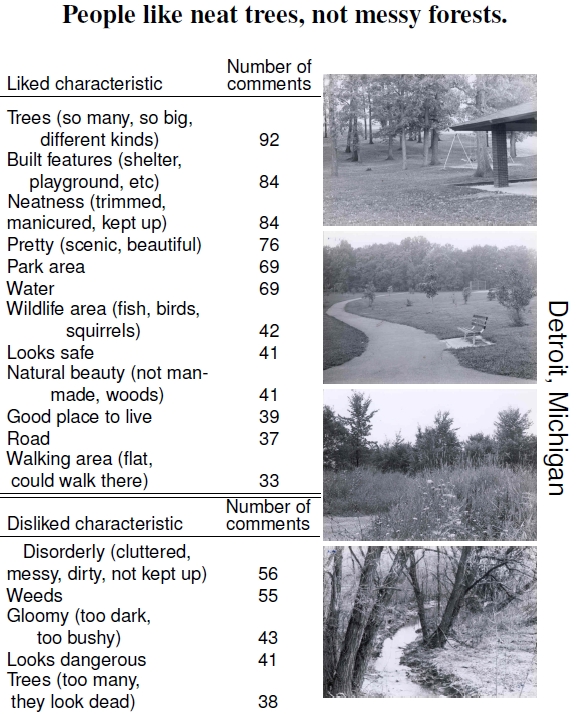5. 4 Neat Nature Please
Figure 5.4: Liked and disliked features about open spaces in a black neighborhood in Detroit, Michigan (photos courtesy of Rachel Kaplan, after Talbot and Kaplan 1984). Humans favor the top two areas over the more natural bottom two areas. Overall, people found high value in open spaces.
What characteristics of urban nature do people value? The results presented in Figure 5.4 summarize interviews of 97 people living in three low- to middle-income neighborhoods in Detroit, of whom 97% were black (presumably two or three nonblacks).[17] People’s likes and dislikes sometimes conflict with one another when it comes to features of open spaces. For example, both “neatness” and “natural beauty” appear in the list of liked characteristics. One comment by the scientists undertaking the study revealed the importance of underlying experiences.[18] People who always lived in the city — never lived outside the city — disliked woodsy creek images and disorderly places, whereas elderly folks, presumably with more rural experiences, had the exact opposite feelings. Conversations with Durham’s urban foresters revealed that they receive demanding calls from citizens that natural areas be mowed and cut back upon the mere sighting of a snake.[19] Efforts to increase and manage urban vegetation and trees must account for people’s disparate views.
Apparently, city people aren’t aware that natural areas include, by definition, general disorder: fallen branches, tangled shrubs, and, yes, snakes, insects, and rodents. Overall, ecologists and environmentalists have an educational challenge ahead of them to teach citizens more about natural beauty and help them align urbanites’ sense of beauty with the beauty that nature yields. Perhaps the motto for urban open space should be “as natural as can be under the circumstances.”
As I mentioned earlier, “Adopt-a-Stream” approaches modified as “Adopt-an-Ecosystem” programs could help raise the nonmarket value of open space because the personal connections have worth in people’s hearts. Even adopt-a-tree programs scaled down to single, neighborhood trees would help. I value the many trees I’ve planted through the years; many are still growing, and I still remember several trees that died through fault or no fault of my own. The value of these trees reflects that of my family’s chickens, and the search for ecosystem services ought not dismiss nonmarket goods. Other citizens may initially treat trees like a coffee cup (“No thanks, I don’t need trees because I have this pretty lawn”) but once lawn-owners plant trees and begin to value them like pet chickens, perhaps their nonmarket value will increase.
———————————–
[17]Talbot and Kaplan (1984) performed the surveys of liked and disliked features about urban open spaces.
[18]Of course, nature provides negative experiences, too. I once took a walk in my North Carolina woods at the end of August and came back with about a 100 two-week-itch-worthy chigger bites. How do I value that aspect of nature?
[19]Anecdotes like urban foresters reporting “mow it down now!” calls based on snake sightings have support in controlled surveys. For example, Knight (2008) reports that, in addition to snakes, people hate wolves, cougars, bats, and spiders, too, though they tend to support preservation of the mammals through government regulation more strongly than the others.
